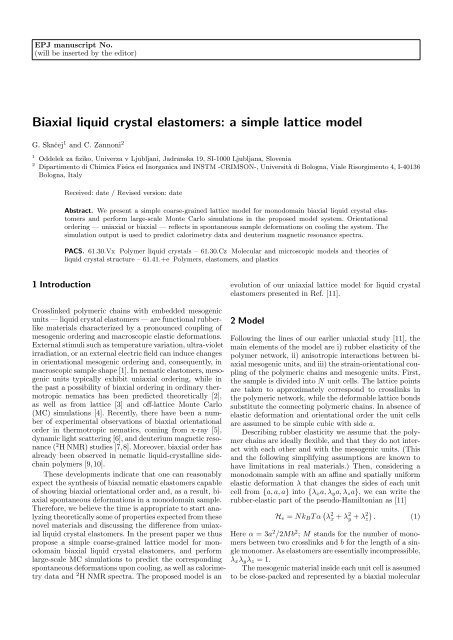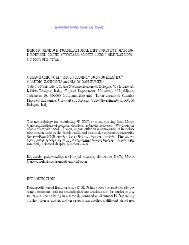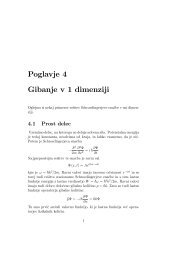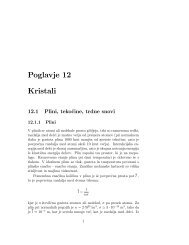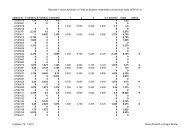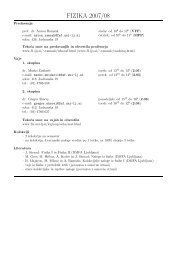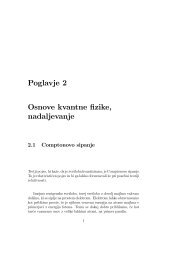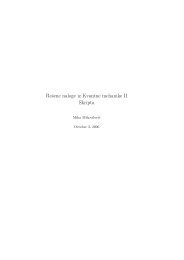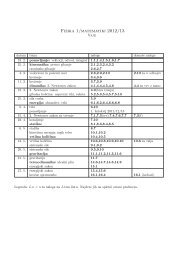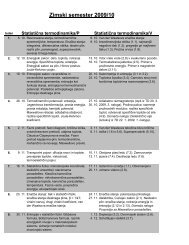Biaxial liquid crystal elastomers: a simple lattice model - Univerza v ...
Biaxial liquid crystal elastomers: a simple lattice model - Univerza v ...
Biaxial liquid crystal elastomers: a simple lattice model - Univerza v ...
- No tags were found...
You also want an ePaper? Increase the reach of your titles
YUMPU automatically turns print PDFs into web optimized ePapers that Google loves.
EPJ manuscript No.(will be inserted by the editor)<strong>Biaxial</strong> <strong>liquid</strong> <strong>crystal</strong> <strong>elastomers</strong>: a <strong>simple</strong> <strong>lattice</strong> <strong>model</strong>G. Skačej 1 and C. Zannoni 21 Oddelek za fiziko, <strong>Univerza</strong> v Ljubljani, Jadranska 19, SI-1000 Ljubljana, Slovenia2 Dipartimento di Chimica Fisica ed Inorganica and INSTM -CRIMSON-, Università di Bologna, Viale Risorgimento 4, I-40136Bologna, ItalyReceived: date / Revised version: dateAbstract. We present a <strong>simple</strong> coarse-grained <strong>lattice</strong> <strong>model</strong> for monodomain biaxial <strong>liquid</strong> <strong>crystal</strong> <strong>elastomers</strong>and perform large-scale Monte Carlo simulations in the proposed <strong>model</strong> system. Orientationalordering — uniaxial or biaxial — reflects in spontaneous sample deformations on cooling the system. Thesimulation output is used to predict calorimetry data and deuterium magnetic resonance spectra.PACS. 61.30.Vx Polymer <strong>liquid</strong> <strong>crystal</strong>s – 61.30.Cz Molecular and microscopic <strong>model</strong>s and theories of<strong>liquid</strong> <strong>crystal</strong> structure – 61.41.+e Polymers, <strong>elastomers</strong>, and plastics1 Introductionevolution of our uniaxial <strong>lattice</strong> <strong>model</strong> for <strong>liquid</strong> <strong>crystal</strong><strong>elastomers</strong> presented in Ref. [11].Crosslinked polymeric chains with embedded mesogenicunits — <strong>liquid</strong> <strong>crystal</strong> <strong>elastomers</strong> — are functional rubberlikematerials characterized by a pronounced coupling ofmesogenic ordering and macroscopic elastic deformations.External stimuli such as temperature variation, ultra-violetirradiation, or an external electric field can induce changesin orientational mesogenic ordering and, consequently, inmacroscopic sample shape [1]. In nematic <strong>elastomers</strong>, mesogenicunits typically exhibit uniaxial ordering, while inthe past a possibility of biaxial ordering in ordinary thermotropicnematics has been predicted theoretically [2],as well as from <strong>lattice</strong> [3] and off-<strong>lattice</strong> Monte Carlo(MC) simulations [4]. Recently, there have been a numberof experimental observations of biaxial orientationalorder in thermotropic nematics, coming from x-ray [5],dynamic light scattering [6], and deuterium magnetic resonance( 2 H NMR) studies [7,8]. Moreover, biaxial order hasalready been observed in nematic <strong>liquid</strong>-<strong>crystal</strong>line sidechainpolymers [9,10].These developments indicate that one can reasonablyexpect the synthesis of biaxial nematic <strong>elastomers</strong> capableof showing biaxial orientational order and, as a result, biaxialspontaneous deformations in a monodomain sample.Therefore, we believe the time is appropriate to start analyzingtheoretically some of properties expected from thesenovel materials and discussing the difference from uniaxial<strong>liquid</strong> <strong>crystal</strong> <strong>elastomers</strong>. In the present paper we thuspropose a <strong>simple</strong> coarse-grained <strong>lattice</strong> <strong>model</strong> for monodomainbiaxial <strong>liquid</strong> <strong>crystal</strong> <strong>elastomers</strong>, and performlarge-scale MC simulations to predict the correspondingspontaneous deformations upon cooling, as well as calorimetrydata and 2 H NMR spectra. The proposed <strong>model</strong> is an2 ModelFollowing the lines of our earlier uniaxial study [11], themain elements of the <strong>model</strong> are i) rubber elasticity of thepolymer network, ii) anisotropic interactions between biaxialmesogenic units, and iii) the strain-orientational couplingof the polymeric chains and mesogenic units. First,the sample is divided into N unit cells. The <strong>lattice</strong> pointsare taken to approximately correspond to crosslinks inthe polymeric network, while the deformable <strong>lattice</strong> bondssubstitute the connecting polymeric chains. In absence ofelastic deformation and orientational order the unit cellsare assumed to be <strong>simple</strong> cubic with side a.Describing rubber elasticity we assume that the polymerchains are ideally flexible, and that they do not interactwith each other and with the mesogenic units. (Thisand the following simplifying assumptions are known tohave limitations in real materials.) Then, considering amonodomain sample with an affine and spatially uniformelastic deformation λ that changes the sides of each unitcell from {a, a, a} into {λ x a, λ y a, λ z a}, we can write therubber-elastic part of the pseudo-Hamiltonian as [11]H e = Nk B T α ( λ 2 x + λ 2 y + λ 2 z). (1)Here α = 3a 2 /2Mb 2 ; M stands for the number of monomersbetween two crosslinks and b for the length of a singlemonomer. As <strong>elastomers</strong> are essentially incompressible,λ x λ y λ z = 1.The mesogenic material inside each unit cell is assumedto be close-packed and represented by a biaxial molecular
2 G. Skačej, C. Zannoni: <strong>Biaxial</strong> <strong>liquid</strong> <strong>crystal</strong> <strong>elastomers</strong>: a <strong>simple</strong> <strong>lattice</strong> <strong>model</strong>cluster — “particle”. For the ith unit cell its orientationis given by the orthonormal triad {s i , t i , u i }. Then, let t iand u i correspond to the short and long axis of the cluster,respectively. Assuming that the interaction between themolecular clusters is predominantly of dispersive origin(for a more general case see, e.g., [12]), the correspondingHamiltonian reads [3]H n = −ɛ ∑ 〈ij〉{R200 (ω ij ) + 2ν [ R 2 02(ω ij ) + R 2 20(ω ij ) ]+4ν 2 R 2 22(ω ij ) } (2)where the sum runs over nearest neighbor cells i and j(assuming periodic boundary conditions), ɛ > 0 is a constant,and ν is the cluster biaxiality parameter. ω ij standsfor the relative orientation of the neighboring particles iand j, defined by the three Euler angles, α ij , β ij , and γ ij .R 2 mn are combinations of Wigner functions and are givenby [13]R 2 00(ω ij ) = 3 2 cos2 β ij − 1 2 , (3)R 2 02(ω ij ) =√38 sin2 β ij cos 2γ ij , (4)R 2 20(ω ij ) =√38 sin2 β ij cos 2α ij , (5)R 2 22(ω ij ) = 1 4 (cos2 β ij + 1) cos 2α ij cos 2γ ij −12 cos β ij sin 2α ij sin 2γ ij . (6)Alternatively, in terms of orthonormal triads the R 2 mnsbecomeR00(ω 2 ij ) = 3 2 (u i · u j ) 2 − 1 2 , (7)√3R02(ω 2 ij ) + R20(ω 2 [ij ) = (ti · t j ) 2 − (s i · s j ) 2] , (8)2R22(ω 2 ij ) = 1 [(ti · t j ) 2 + (s i · s j ) 24mesogenic particles experience an aligning mechanical fieldalong the fixed stretch direction, with a strain-dependentfield strength. In the original Maier-Saupe theory for uniaxialnematics [15,16], the local aligning field strength isproportional to the degree of order of the surrounding nematicmaterial. Analogously, here we adapt the mean-fieldtreatment of orientational ordering in <strong>liquid</strong> <strong>crystal</strong>s proposedby Straley for the biaxial case [2]. Then, denotingwith ω i the Euler angles for a relative orientation of ithparticle and {x, y, z} — an orthonormal triad defining theprincipal axes of the biaxial sample deformation — onecan write a coupling pseudo-HamiltonianH c = − k B T χN∑ [r200 (λ)R00(ω 2 i ) + 2r20(λ)R 2 20(ω 2 i ) ] ,i=1(10)where χ is a coupling constant and rmn(λ) 2 are the deformation-dependentquantities measuring the anisotropyof the polymer chain end-to-end tensor distribution (and,consequently, the strength of the mechanical field components).This distribution is represented by a biaxial ellipsoidE obtained by deforming a unit sphere at constantvolume by the factors λ x , λ y , and λ z along x, y, and z, respectively.Denoting with θ and φ the polar and azimuthalangles measured with respect to z and x, respectively, andwith Ω the corresponding solid angle, the rmns 2 are definedas∫ ( 3r00(λ) 2 = (4π) −1 E(λ) 2 cos2 θ − 1 )dΩ, (11)2∫ √3r20(λ) 2 = (4π) −1 8 sin2 θ cos 2φ dΩ (12)E(λ)and are calculated numerically using the Simpson quadratureformula upon every deformation λ. In H c , R 2 mn(ω i )biaxial uniaxial isotropic−(t i · s j ) 2 − (s i · t j ) 2] . (9)For ν = 0 H n reduces to the Lebwohl-Lasher Hamiltonianfor uniaxial particles [14], while 0 < ν < 1/ √ 6 and ν >1/ √ 6 simulate prolate (rod-like) and oblate (plate-like)biaxial particles, respectively. Depending on temperatureand ν, an ensemble of biaxial particles can be found inthe isotropic (I), nematic (N), or biaxial (B) phase. Inthe isotropic phase, no orientational order is present. Inthe nematic phase, for prolate particles their long axes u ialign, which is referred to as the “positive” nematic phase(N + ); analogously, oblate particles align along their shortaxes t i , forming the “negative” nematic phase (N − ). Inthe biaxial phase, all three particle axes (s i , t i , u i ) arealigned [3].Finally, orientational ordering couples to strain, seeFig. 1. In the uniaxial version of the <strong>model</strong> [11] this couplingis implemented via a Maier-Saupe-like mean field:(a)(c)Fig. 1. Schematic depiction of sample shape (reflecting thesymmetry of the polymer chain end-to-end tensor distribution)for different types of orientational ordering. In all cases the nematicdirector is vertical. (a-b) Positive materials with prolatemesogens, as well as negative materials with oblate mesogens.(c-d) Positive materials with oblate mesogens, or negative materialswith prolate mesogenic units. (e) Undeformed sample,no orientational order (idealization).(b)(d)(e)
4 G. Skačej, C. Zannoni: <strong>Biaxial</strong> <strong>liquid</strong> <strong>crystal</strong> <strong>elastomers</strong>: a <strong>simple</strong> <strong>lattice</strong> <strong>model</strong>ν = 0ν = 0.2ν = 1/ √ 6ν = 0.6T ∗ = 2.00T ∗ = 1.50T ∗ = 1.00T ∗ = 0.50-1.00.0 1.0ω Q /δω Q-1.00.0 1.0ω Q /δω Q-1.00.0 1.0ω Q /δω Q-1.00.0 1.0ω Q /δω QT ∗ = 0.05Fig. 3. Temperature dependence of 2 H NMR spectra for different values of ν. The spectrometer magnetic field was directedalong x, y, and z; the resulting spectral sets are superimposed. Positive material, χ = 0.5. Note the absence of hysteresis (atpresent resolution).denotes a coupling constant [20]. Then, the spectra can becalculated by generating the free induction decay signal〈 ( ∫ t)〉G(t) = exp i ω j Q (t′ ) dt ′ , (17)where 〈· · ·〉 j stands for ensemble averaging over particles,and Fourier-transforming it [21]. We believe that the MCreorientation moves reproduce the real mesogenic dynamicssufficiently well to produce reliable NMR spectra. — Ineach run, we have simultaneously calculated three spectra,with the spectrometer magnetic field directed along x, y,and z, to easily detect any biaxiality in ordering. Translationaldiffusion was neglected. The duration of one NMRcycle, 2π/δω Q , was fixed to 1024 MC cycles. Finally, forsmoothening, a convolution with a Lorentzian kernel ofappropriate width was applied.4 ResultsHeating/cooling runs have been performed for positiveand negative materials, as well as for different values ofthe biaxiality parameter ν. The parameter α [see Eq. (1)]that is related to the elastic modulus of the material was0jset to 0.3 as in Ref. [11]. Spontaneous deformation types,as observed during the cooling runs, are shown schematicallyin Fig. 1.Consider positive materials with χ = 0.5 first. Settingν = 0, the pair potential for the interaction betweenmesogenic units, Eq. (2), becomes uniaxial as in Ref. [11].On cooling from the isotropic phase the specific heat c ∗ V(Fig. 2, top) peaks at T ∗ = k B T/ɛ ≈ 1.141 ± 0.003 [11],which is a signature of the weakly first-order isotropicnematic(IN + ) phase transition. (A more detailed analysis[11] shows that the transition temperature is shiftedto a slightly higher value in comparison with the ordinary<strong>liquid</strong> <strong>crystal</strong>, which is attributed to the order-stabilizingeffect of the mechanical field.) The particle alignment isaccompanied by a spontaneous deformation of about 8%along the director (Fig. 2, bottom) and a lateral contractionof about 4% to maintain volume constant. Coolingto even lower T ∗ , the spontaneous deformation increasestogether with the degree of nematic order. Fig. 3 showsthe corresponding 2 H NMR spectra, with superimposedcurves for different spectrometer field orientations: b||x, y,or z, i.e., parallel or perpendicular to the nematic directorn. In the isotropic phase a single line at zero quadrupolarsplitting is observed. In the nematic phase, however, adoublet appears at ±∆ω and ±∆ω/2 for b||n and b ⊥ n,
G. Skačej, C. Zannoni: <strong>Biaxial</strong> <strong>liquid</strong> <strong>crystal</strong> <strong>elastomers</strong>: a <strong>simple</strong> <strong>lattice</strong> <strong>model</strong> 5respectively, where ∆ω denotes the maximum frequencysplitting observed for a given degree of order. The spectrafor b ⊥ n overlap as long as ordering is uniaxial. DecreasingT ∗ , ∆ω — proportional to the degree of nematicordering — increases.Weakly biaxial prolate particles with ν = 0.2 exhibitbiaxial order, however only for T ∗ < 0.2. This can be deducedfrom a second peak in the temperature dependenceof c ∗ V reflecting the nematic-biaxial (N +B) transition. TheN + B transition is of the second-order: the c ∗ V peak is notas sharp as the one at T ∗ ≈ 1.15 attributed to the IN +transition. For ν = 0.2 the biaxiality is too weak to be detectablefrom asymmetries in lateral sample contractionor in 2 H NMR spectra for b ⊥ n.In the ordinary <strong>liquid</strong> <strong>crystal</strong>, the stability temperaturerange of the biaxial phase is widest at the limitbetween prolate and oblate particles (for ν = 1/ √ 6 ≈0.4082) where there is a direct second-order isotropic-biaxial(IB) transition [3] at the Landau point. Performing a coolingrun with our <strong>model</strong> elastomer for ν = 1/ √ 6 ≈ 0.4082this direct IB transition splits into a pair of near transitions:IN + at T ∗ ≈ 1.17 ± 0.01 and N + B at T ∗ ≈0.96 ± 0.01. The latter transition can be reliably detectedonly from the asymmetry in lateral sample dimensions asthe corresponding c ∗ V peak is extremely broad. The biaxialasymmetry is now clearly visible also from 2 H NMRspectra: the two b ⊥ n spectral sets do not overlap anylonger, except in the narrow temperature window whereordering is uniaxial.Results from more detailed temperature scans are summarizedin the phase diagram shown in Fig. 4. From thediagram one can deduce that the Landau point has actuallymoved to ν ≈ 0.414 ± 0.001, i.e., that the stabilityrange of the N + phase formed by prolate (rod-like) mesogenicparticles has slightly increased at the expense of theN − phase formed by oblate (plate-like) particles. This isanother consequence of the mechanical field presence: asin our <strong>model</strong> the particle alignment couples to strain exclusivelyvia the orientation of the particle long axis u i —see the expression for H c — the mechanical field stabilizes1.31.2IT1.1∗ N +1.0N −0.9B0.80.40 0.41 0.42 0.43 0.44 0.45νFig. 4. Orientational phase diagram of a biaxial elastomer(positive material, χ = 0.5). Note the shift of the Landau pointfrom ν = 1/ √ 6 ≈ 0.4082 (dashed line) to a slightly highervalue.c ∗ V8.06.04.02.00.01.11.0λ x,y,z0.90.0 0.5 1.0 1.5 2.0Fig. 5. Same as Fig. 2 (including key), yet for a negative materialwith χ = −0.5. While the c ∗ V temperature dependences(top) are almost identical to those calculated for the positivematerial, the sample deformations λ x, λ y, and λ z (bottom) arequite different.the alignment of u i , rather than that of the short axes t i .Hence, the N + phase becomes favored over N − .For oblate particles the isotropic phase on cooling transformsinto the negative nematic phase, where the shortparticle axes are aligned. While for prolate particles theIN + transition temperature was essentially ν-independent,this is no longer the case for oblate particles. For ν = 0.6the IN − transition takes place at T ∗ ≈ 1.75, while theN − B transition can be observed at T ∗ ≈ 0.50; see Fig. 2.In the N − phase the sample contracts along the directorand expands laterally. The degeneracy of the lateral samplesides is lifted once in the biaxial phase. The 2 H NMRspectra show two pairs of peaks: one at ±∆ω/2 and oneat ±∆ω/4, corresponding to b||n and b ⊥ n, respectively.(Recall that n here is assigned to the average orientationof the short molecular axes t i and that the EFG tensorprincipal axis is directed along the long axes u i that areassumed to move fast on the 2 H NMR time scale.) Again,the peaks at ±∆ω/4 split once biaxial order is obtained.We have also performed a sequence of heating runsthat are also shown in all plots. Note that the curves essentiallyoverlap and hysteresis in all cases (at currentprecision) is negligible.Let us also comment on negative (e.g., end-on sidechain) materials, taking χ = −0.5. The orientational or-T ∗
6 G. Skačej, C. Zannoni: <strong>Biaxial</strong> <strong>liquid</strong> <strong>crystal</strong> <strong>elastomers</strong>: a <strong>simple</strong> <strong>lattice</strong> <strong>model</strong>dering behavior (and, consequently, the resulting 2 H NMRspectra) is essentially the same as for positive materials.The main difference appears in average sample dimensions:for example, in the N + phase a positive materialexpands along n, while a negative material contracts(Fig. 5). In the N − phase a positive material contractsalong n, and vice versa for a negative material. Again, inthe B phase, the symmetry of the two lateral components(perpendicular to n) is broken. See also Fig. 1.Finally, recall that experimentally monodomain samplesare prepared in a two-step crosslinking procedure [22]that typically results in imprinted residual orientationalorder [23,24]. Therefore, perfectly isotropic monodomainsamples are never obtained. The fact that at high enoughtemperatures the <strong>model</strong> elastomer presented in this analysisis found in the isotropic phase, while it is also supposedto represent a monodomain sample, should be regarded asyet another simplifying assumption of the <strong>model</strong>.5 ConclusionsWe have developed a <strong>simple</strong> coarse-grained <strong>lattice</strong> <strong>model</strong>for monodomain biaxial <strong>liquid</strong> <strong>crystal</strong> <strong>elastomers</strong>, treating<strong>elastomers</strong> with both prolate and oblate mesogenicunits, as well as positive and negative materials in termsof strain-alignment coupling. Our <strong>model</strong> elastomer can befound in the biaxial, uniaxial nematic (either positive ornegative), and isotropic phase, which clearly reflects inpredicted average sample shape, as well as in simulated2 H NMR spectra. The stability range of rod-like (prolate)nematic ordering is slightly increased at the expense ofplate-like (oblate) ordering, which implies a shift of theLandau point to a somewhat higher molecular biaxialityvalue in comparison with an ordinary biaxial nematic.7. L. A. Madsen, T. J. Dingemans, M. Nakata, and E. T.Samulski, Phys. Rev. Lett. 92, 145505 (2004).8. J. L. Figueirinhas, C. Cruz, D. Filip, G. Feio, A. C. Ribeiro,Y. Frère, T. Meyer, and G. H. Mehl, Phys. Rev. Lett. 94,107802 (2005).9. K. Severing and K. Saalwächter, Phys. Rev. Lett. 92,125501 (2004).10. K. Severing, E. Stibal-Fischer, A. Hasenhindl, H. Finkelmann,and K. Saalwächter, J. Chem. Phys. B 110, 15680(2006).11. P. Pasini, G. Skačej, and C. Zannoni, Chem. Phys. Lett.413, 463 (2005).12. A. M. Sonnet, E. G. Virga, and G. E. Durand, Phys. Rev.E 67, 061701 (2003).13. M. E. Rose, Elementary Theory of Angular Momentum(Wiley, New York 1957).14. P. A. Lebwohl and G. Lasher, Phys. Rev. A 6, 426 (1972).15. W. Maier and A. Saupe, Z. Naturforsch. A 14, 882 (1959).16. W. Maier and A. Saupe, Z. Naturforsch. A 15, 287 (1960).17. N. Metropolis, A. W. Rosenbluth, M. N. Rosenbluth, A.H. Teller, and E. Teller, J. Chem. Phys. 21, 1087 (1953).18. J. A. Barker and R. O. Watts, Chem. Phys. Lett. 3, 144(1969).19. U. Fabbri and C. Zannoni, Mol. Phys. 58, 763 (1986).20. R. Y. Dong, Nuclear Magnetic Resonance of Liquid Crystals(Springer Verlag, New York 1994).21. C. Chiccoli, P. Pasini, G. Skačej, S. Žumer, and C. Zannoni,Phys. Rev. E 60, 4219 (1999).22. J. Küpfer and H. Finkelmann, Macromol. Chem. RapidComm. 12, 717 (1991).23. H. R. Brand and K. Kawasaki, Macromol. Rapid Commun.15, 251 (1994).24. A. Lebar, Z. Kutnjak, S. Žumer, H. Finkelmann, A.Sánchez-Ferrer, and B. Zalar, Phys. Rev. Lett. 94, 197801(2005).This work was carried out within the FULCE (Functional LiquidCrystalline Elastomers) Research Training Network fundedby the European Union. Further financial support from PRIN#2005035119 and the Slovene-Italian bilateral project BI-IT/06-09-F9 (Mrežne simulacije tekočekristalnih elastomerov/Simulazionisu reticolo di elastomeri <strong>liquid</strong>o cristallini) is acknowledged.References1. M. Warner and E. M. Terentjev, Liquid Crystal Elastomers(Oxford University Press, Oxford 2003).2. J. P. Straley, Phys. Rev. A 10, 1881 (1974 .3. F. Biscarini, C. Chiccoli, P. Pasini, F. Semeria, and C. Zannoni,Phys. Rev. Lett. 75, 1803 (1995).4. R. Berardi and C. Zannoni, J. Chem. Phys. 113, 5971(2000).5. B. R. Acharya, A. Primak, and S. Kumar, Phys. Rev. Lett.92, 145506 (2004).6. K. Neupane, S. W. Kang, S. Sharma, D. Carney, T. Meyer,G. H. Mehl, D. W. Allender, S. Kumar, and S. Sprunt, Phys.Rev. Lett. 97, 207802 (2006).


